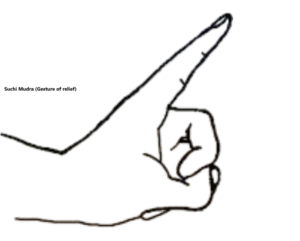Suchi Mudra (Gesture of relief)
Introduction
Suchi Mudra, also called the “Pointer Finger Gesture,” is a hand mudra in yoga that enhances mental clarity, focus, and calmness. It is one of the simplest mudras, often used during meditation, pranayama, or daily mindfulness practices.
The term Suchi means needle or pointer in Sanskrit, symbolizing precision and concentration. Practicing this mudra is believed to channel energy into improving focus, memory, and spiritual awareness.
Meaning
Suchi: Needle or pointer – representing focus, precision, and direction.
Mudra: Gesture used to direct energy flow in the body and mind.
Overall Meaning:
Suchi Mudra encourages mental focus, clarity of thought, and calmness. It symbolizes directing your energy toward a single point of intention, improving concentration and meditation quality.
How to Perform / Practice
Sit in a comfortable meditative posture (Padmasana, Sukhasana, or on a chair) with the spine erect.
Extend your index finger straight.
Fold the other three fingers (middle, ring, and little finger) so that the thumb touches the tips of these three fingers gently.
Keep the hand relaxed and place it on your lap or thighs with the palm facing upward.
Close the eyes and focus on steady breathing.
Maintain the mudra for 15–30 minutes daily. Short intervals of 5–10 minutes can also be beneficial during work or study.
Tip: Practice on an empty stomach or after light meals for better results.
Benefits
Physical Benefits:
Enhances fine motor coordination in fingers and hands.
Promotes relaxation and reduces hand fatigue.
Improves blood circulation in the fingers.
Mental & Emotional Benefits:
Improves concentration and attention span.
Calms the mind and reduces stress, anxiety, and restlessness.
Enhances memory and mental clarity.
Helps manage overthinking and emotional imbalance.
Energetic / Spiritual Benefits:
Directs energy (prana) to higher mental centers.
Supports mindfulness and meditation practices.
Balances subtle energies in the body.
Contraindications
Avoid if there is joint pain, arthritis, or recent injury in fingers or hands.
Should not be forced if finger flexibility is limited.
Discontinue if numbness or tingling occurs.
Anatomy & Physiology
Muscles: Intrinsic hand muscles (lumbricals, interossei) maintain the finger positions.
Joints: Flexion at the metacarpophalangeal joints for folded fingers; extension at the index finger.
Nervous System: Promotes parasympathetic activation, reducing stress response.
Circulation: Gentle finger placement improves microcirculation in the hand.
Kinesiology
Improves fine motor control of fingers.
Enhances neuromuscular coordination between brain and hands.
Supports static postural stability during seated meditation.
Neurology
Stimulates attention and sensory integration centers in the brain.
Activates vagus nerve indirectly through parasympathetic pathways.
Supports neural plasticity, helping focus and memory over time.
Duration of Practice
Daily Practice: 15–30 minutes, can be divided into 2–3 sessions.
Short Practice: 5–10 minutes during work or study breaks to regain focus.
Can be combined with pranayama or meditation for enhanced benefits.
Counter Mudra
If the mind becomes rigid or tense, switch to Shunya Mudra or Chala Mudra to release excess energy.
Gentle hand stretching or shaking after prolonged practice is advised.
Conclusion
Suchi Mudra is a simple yet effective gesture to enhance mental clarity, focus, and emotional calmness. Regular practice balances body and mind energies, making it a useful tool for meditation, study, and daily mindfulness. Proper and gentle execution ensures maximum benefits without discomfort.
FAQ
Q1: Can beginners practice Suchi Mudra?
A: Yes, it is simple and safe. Start with 5–10 minutes and gradually increase.
Q2: Can it be combined with other mudras?
A: Yes, often used with Gyan Mudra or Dhyana Mudra for meditation.
Q3: Will it help with stress and anxiety?
A: Yes, by stimulating parasympathetic activity, it promotes calmness and mental stability.
Q4: Can it be practiced while walking?
A: Not recommended; best practiced seated for focus and stability.
References
Swami Satyananda Saraswati, Mudras for Healing and Transformation.
Iyengar, B.K.S., Light on Yoga.
Saraswati, S., Pranayama and Mudras in Yoga Therapy.
Fishman, L., Yoga for Emotional Balance.
Journal of Bodywork and Movement Therapies, 2018; 22(4): Effects of Hand Mudras on Mental and Physiological Functions.

